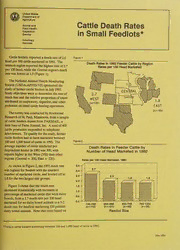
Cattle death rates in small feedlots PDF
Preview Cattle death rates in small feedlots
Historic, Archive Document Do not assume content reflects current scientific knowledge, policies, or practices. Reserve aSF202 -C3¢g 1994 Bas aea eta aga el atsiscte i y United States Department of Agriculture tae Cattle Death Rates ein _ In Small Feedlots* Veterinary Services __ Cattle feeders reported a death rate of 2.0 Figure 1 _ head per 100 cattle marketed in 1992. The Death Rates In 1992 Feeder Cattle by Region _w estern region reported the highest rate of 2.7 Rates per 100 Head Marketed _ per 100 head, while the Central region’s death _ Tate was lowest at 1.5 (Figure 1). ___ The National Animal Health Monitoring _S ystem (USDA:APHIS:VS) sponsored the _ study of farmer cattle feeders in July 1993. _ Study objectives were to determine the rate of _ death loss and the relative proportion of losses "attributed to respiratory, digestive, and other : 4p roblems on small cattle feeding operations. ___ The survey was conducted by Rockwood _R esearch of St. Paul, Minnesota, from a sample of cattle feeders drawn from FARMAIL, a data base of Farm Journal, Inc. A total of 400 "cattle producers responded to telephone _i nterviewers. To qualify for the study, farmer - cattle feeders had to have marketed between 100 and 1,000 head of cattle in 1992. The Figureic ; average number of cattle marketed per Death Rates in Feeder Cattle by | Fespondent feeder in 1992 was 300, with Number of Head Marketed in 1992 reports higher in the West (350) than other _Tegions (Central = 300, East = 220). Rates per 100 Head Marketed, 1992 ___ As shown in Figure 2, the 1992 death rate _w as highest for feeders with the smallest number of marketed cattle, and leveled off at _1 .8 for the two largest size groups. __ Figure 3 shows that the death rate _increased dramatically with increases in _ percentage of marketed cattle that were dairy breeds, from a 1.7 death rate per 100 head "marketed for no dairy breed animals to a 5.2 ronena oho 400 500-746 ae death rate for feedlots marketing 100 percent (n=172) (n=101) (n=92) (n=35) _ dairy breed animals. Note that rates based on Feedlot Size i . i _*Farmer cattle feeders marketing between 100 and 1,000 head of cattle in 1992. 4 May 1994 percent of dairy breed were calculated from small Figure 3 sample sizes and, therefore, caution should be used Death Rates by Percent Marketed when interpreting these data. Also, dairy breed that Were Dairy Breeds and animals are typically on feed longer and, therefore, Percent Raised on the Farm have more days at risk of dying prior to marketing. : Death Rate per 100 Cattle Marketed, 1992 Also shown in Figure 3 is that the 1992 death _ rate was lowest (1.4) for farmer feeders who raised none of the cattle fed on their operation, and increased to its highest level (3.0) for feeders who raised all of their marketed cattle. This may appear to be contrary to conventional wisdom. Calves raised on the premises where they are to be fed are spared the stress of shipment and, in some cases, mixing with cattle from other sources which might decrease illness. One explanation for why the 0 1-49 60-99 100 0 1-49 50-99 100 (n®303) (n*46) (n°23) (n=26) (ne193) (ne77) (n°53) (n*76) death rate rises with the percent raised on farm is Percent Dairy Breeds Percent Raised on Farm that these cattle may be placed on feed at an earlier age (lighter weight) than purchased cattle would Figure 4 be. Raised calves then have a longer period at risk Average Percentage of Deaths Caused by prior to slaughter and lighter-weight calves may Respiratory and Digestive Diseases have more difficulty resisting stress and disease and Other Problems by Region than heavier calves. A Percent of Deaths Producers identified respiratory diseases as the major cause of about two out of three deaths in Region: 1992, more so in the East than in other regions (Figure 4). Cause of death reported by producers did not seem to be associated with number of head marketed (Figure 5). Feedlots with 100-249 head marketed reported the smallest percent of deaths due to respiratory disease and the highest percent Respiratory Other Problems Digestive of deaths due to digestive diseases. The percent of Disease Group deaths due to digestive diseases decreases as the Figure 5 number of head marketed increases. Average Percentage of Deaths Caused by The cause of death reported by producers was Respiratory and Digestive Diseases & not associated with percentage of cattle marketed Other Problems by Number of Head Marketed that were dairy breeds (not shown). Deaths attributed to other problems was higher for farmers Percent of Deaths who raise a high percentage (> 50 percent) of the cattle they place on feed (not shown). For more information, contact: Disease Group: & Respiratory Other Centers for Epldmliology & Animal Health Digestive USDA:APHIS:VS, Attn. NAHMS 20 KCIGNKS ISTA 555 South Howes, Suite 200 IGEN = Fort Collins, Colorado 80521 (303)490-7800 100-249 = = 750+ _ Internet: [email protected] (n=122) (n=94) (n=87) (n=33) Herd Size N134.594 Wi *k NATIONAL AGRIC 1022273520 atgeepie Sete asom SPApA eae tea ne etaeeit,n bti oteee eh y eenker Hb by 9,f t i ay ie bias thats — enplfswit la ea n oh ‘at 3 oi Sea we
